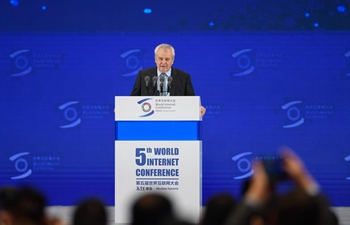LONDON, Nov. 10 (Xinhua) -- The rate of growth in the British economy has reached a pre-Brexit peak after a period of above-average GDP increase, and now looks set to return to a more normal path, the National Institute of Economic and Social Research (NIESR) revealed on Saturday.
"It is not a bleak picture, it is a case of growth easing back from growth of 0.7 percent per quarter which is not sustainable," Amit Kara, head of UK macroeconomic policy at NIESR, told Xinhua after the institute revealed its rolling three-monthly forecast for UK's gross domestic product (GDP).
The forecast saw a revision downwards for the growth of the third and fourth quarter this year and a month-on-month fall in the GDP growth rate in October.
"We have revised down our estimate of growth for the third quarter from 0.7 percent to 0.6 percent and for the fourth quarter from 0.5 percent to 0.4 percent," Kara said.
Growth in the economy slumped in the first quarter this year in a surprise downward fall to just 0.1 percent quarter on quarter, largely on the back of an unusually prolonged period of poor weather with below-average temperatures.
That growth lost in the first quarter was recovered in the second and third quarters, according to the NIESR as well as latest data from the Office of National Statistics.
"The broad picture is that 0.7 percent a quarter was never sustainable," said Kara.
"The strength in the early part of Q3 largely reflects a build-up of momentum after the slowdown in the first quarter of this year. You could call it catch-up or a rebalancing."
This is considerably above the trend growth seen in the economy, since the Brexit referendum in mid 2016.
Furthermore, Kara said the apparent strength in third quarter growth masks a loss in momentum in industrial production as well as services output in the latter part of the third quarter.
There are a number of factors at play in the fall in the rate of growth, including Brexit-related uncertainty.
"If we look at the post-referendum period the growth rate is about 0.4 percent per quarter, and for the post-financial crisis period it is about 0.3 percent to about 0.5 percent," Kara noted.
"The outlook for growth is particularly uncertain, especially with the exit date from the European Union fast approaching and the terms of the future relationship yet to be settled," she added.













